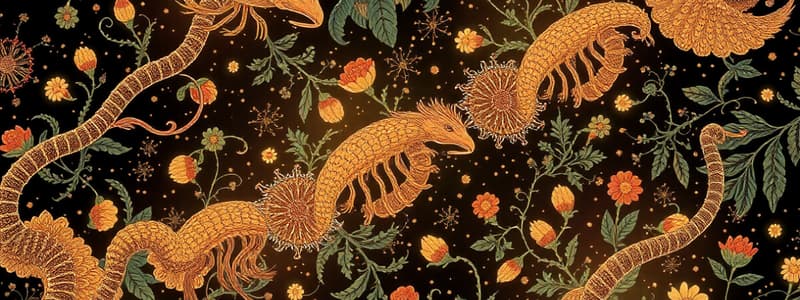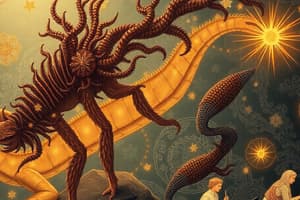Podcast
Questions and Answers
What is the primary role of lipids in organisms?
What is the primary role of lipids in organisms?
- Carrying genetic information and controlling cell processes
- Providing support and protection for cells
- Speeding up chemical reactions and breaking down molecules
- Storing energy and acting as structural components (correct)
Which of the following correctly describes the relationship between DNA and proteins?
Which of the following correctly describes the relationship between DNA and proteins?
- Proteins are made of DNA, and their sequence determines the DNA's function.
- Proteins convert DNA into RNA, which then directs protein synthesis.
- DNA is a component of proteins, and its structure determines the protein's function.
- DNA provides the instructions for building proteins, and proteins carry out various functions. (correct)
What key difference distinguishes prokaryotes from eukaryotes?
What key difference distinguishes prokaryotes from eukaryotes?
- Prokaryotes have a nucleus, while eukaryotes lack a nucleus.
- Eukaryotes evolved from prokaryotes, making them structurally simpler.
- Prokaryotes have a more complex internal organization than eukaryotes.
- Prokaryotes are generally smaller and lack membrane-bound organelles. (correct)
Which of the following cellular components is primarily responsible for packaging and transporting proteins?
Which of the following cellular components is primarily responsible for packaging and transporting proteins?
What is the significance of hydrogen bonds in water molecules?
What is the significance of hydrogen bonds in water molecules?
What is a key difference between saturated and unsaturated fats?
What is a key difference between saturated and unsaturated fats?
What is the correct order of increasing complexity in the hierarchical organization of life?
What is the correct order of increasing complexity in the hierarchical organization of life?
What is the fundamental difference between mutations and natural selection?
What is the fundamental difference between mutations and natural selection?
Flashcards
Three Domains of Life
Three Domains of Life
Bacteria, Archaea, Eukarya - classifications of life.
Natural Selection
Natural Selection
Process where traits that help survival are passed on.
Darwin's Voyage
Darwin's Voyage
Journey on HMS Beagle where he studied species.
Human Genome Size
Human Genome Size
Signup and view all the flashcards
Carbon in Life
Carbon in Life
Signup and view all the flashcards
Types of Chemical Bonds
Types of Chemical Bonds
Signup and view all the flashcards
Cell Membrane
Cell Membrane
Signup and view all the flashcards
Transcription and Translation
Transcription and Translation
Signup and view all the flashcards
Study Notes
Domains of Life
- Three domains—Bacteria, Archaea, and Eukarya
- Bacteria and Archaea are simple, lacking a nucleus
- Eukarya are complex, possess a nucleus, and include plants, animals, and fungi
Darwin & Natural Selection
- Darwin proposed natural selection as the mechanism of evolution.
- Traits vary, and the "best" traits help organisms survive and reproduce more successfully.
- Darwin's observations were made on the HMS Beagle voyage, particularly at the Galapagos Islands.
- Key organisms studied included finches (beaks), tortoises, and iguanas.
- Natural selection relies on unequal reproductive success among individuals.
Human Genome
- The human genome contains approximately 3 billion DNA base pairs.
- Biological organization follows a hierarchical structure from atoms to biomes.
Darwin's Birthday
- Darwin was born on February 12, 1809.
Mutations, DNA & Natural Selection
- Mutations are random changes in DNA.
- Natural selection favors advantageous traits.
- DNA stores and transmits genetic information.
Carbon & Life
- Carbon is essential for life.
- Carbon has 6 protons, 6 neutrons, and 6 electrons.
- Carbon exists in different isotopes, such as Carbon-12 and Carbon-14.
Chemical Bonds
- Covalent bonds are the strongest type of chemical bond.
- Ionic bonds and hydrogen bonds are weaker types of bonds (ionic in water, hydrogen in various forms)
Water & Properties
- Water is a polar molecule.
- Water expands when frozen.
- The pH scale ranges from 0 to 14, with 7 being neutral.
- Rainwater combined with CO2 becomes slightly acidic.
Carbohydrates & Energy
- Polysaccharides (starch, glycogen) are chains of sugars.
- Glycogen serves as a stored energy source in mammals.
Lipids & Fats
- Lipids are composed of fatty acids and glycerol.
- Saturated fats are less desirable than unsaturated fats in excess.
- Hydrogenation is a process that can create bad fats.
- Cholesterol is used in cell membranes and hormones.
Proteins & Nucleic Acids
- Proteins are made of 20 different amino acids, composed of C, H, O, and N.
- Nucleic acids are built from nucleotides (sugar, phosphate, and nitrogen base).
- Protein synthesis involves transcription and translation (DNA to protein).
- Enzymes accelerate chemical reactions.
Cells & Membranes
- Cell membranes are selectively permeable.
- Eukaryotic cells evolved from prokaryotic cells.
- Viruses are smaller than bacteria.
Who Has What?
- Chloroplasts are found in plants.
- Mitochondria are found in most eukaryotes.
- Cell membranes are composed of a phospholipid bilayer.
Organelles & Functions
- Uncondensed DNA is called chromatin.
- Rough ER is involved in protein synthesis.
- Smooth ER is involved in lipid synthesis.
- The Golgi apparatus packages and ships proteins.
- Flagella are used in movement, (e.g., sperm)
- Cilia are shorter and numerous for movement.
- Mitochondria and chloroplasts both produce energy, but using different processes, and both have double membranes.
Energy & Metabolism
- Energy is primarily stored chemically.
- 1 kcal equals 1 Calorie (the dietary calorie).
- Enzymes lower the activation energy needed for reactions.
Osmosis & Cell Solutions
- Hypotonic solutions cause cells to swell.
- Hypertonic solutions cause cells to shrink.
- Isotonic solutions have no effect on cell size.
- Enzymes work by binding to a substrate, changing it, and then releasing the product.
Studying That Suits You
Use AI to generate personalized quizzes and flashcards to suit your learning preferences.




